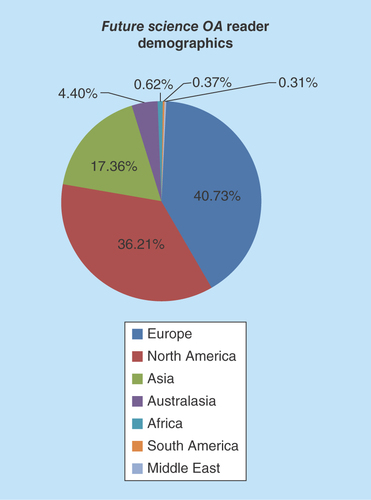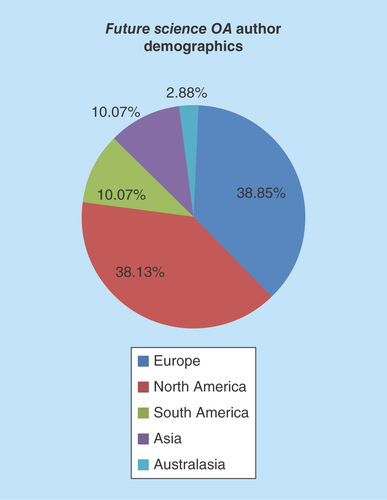Welcome to volume 2 of Future Science OA. 2015 was an exciting year for us, with the publication of our first content and being indexed by the Database of Open Access Journals [Citation1], and we discuss our highlights from the past year in this Foreword. We would like to take this opportunity to thank our editorial board, authors, peer reviewers and readers for their contributions thus far. We look forward to working with you all over the coming year.
Content highlights from 2015
We published over 70 articles in 2015, which comprised editorials, opinion pieces, reviews and original research from an international group of authors. Covering a wide range of topics of relevance to medicine, we have seen over 2500 full-text readers each month, from across the globe. The majority of our readers are within North America, Europe and Asia, with readers also across Australasia, South America, the Middle East and Africa (). This is a pattern also seen in our authorship, with two-thirds of our authors residing in Europe and North America (). In 2016, we are excited to be partnering with Enago [Citation2], who will provide our authors for whom English is a second language with pre-submission editing and translation services. We hope this will further expand our publications from countries around the globe.
Our most-read article saw Françoise Barré-Sinoussi and Xavier Montagutelli (Institut Pasteur, France) provide an insight into their thoughts on the future of animal models in biological research [Citation3], following the ‘Stop Vivisection’ European Citizen Initiative presented to the EC. Covering many of the issues facing the use (and potential future non-use) of animals in research, they presented why they feel animal use will remain an essential feature of research, in the near future at least.
With the increasing prevalence of Alzheimer's disease and the continued lack of an effective therapy, Ruth MacLeod and colleagues (University of Glasgow, UK) reviewed the role and therapeutic targeting of secretases in Alzheimer's disease [Citation4], asking whether targeting amyloid is a viable hypothesis.
Mariana Varna and colleagues (Inserm-X Bichat Hospital, France) reviewed current work looking into the potential of nanomedicine to help solve the issue of inactivation of thrombolytic drugs in the blood [Citation5]. They eagerly await validation of nanosystems in this arena ready for the clinic. In further nanomedicine news, Jun Fang and colleagues (Sojo University, Japan) presented research examining the potential of a tumor-targeted nanoprobe for photodynamic therapy and tumor imaging [Citation6].
Gaurav Agrawal, Thomas Borody and colleagues (Centre for Digestive Diseases, Australia) presented a case report evaluating a novel combination therapy for resistant fistulizing Crohn's disease [Citation7].
Other top articles to highlight include Andreea Milasan and colleagues’ review of the lymphatic network in atherosclerosis [Citation8], Bejoy Thomas et al.'s case report demonstrating a need for more collaboration to ensure literature reviews are comprehensive [Citation9], a new generic model to help the development of applications for clinical decision-making created by Tibor van Rooij and colleagues [Citation10], an examination of the potential uses of the STAT3 pathway in genitourinary tumors [Citation11], and, finally, a research article examining the potential of extracellular embryo genomic DNA for genotyping applications [Citation12]. This content is merely a snapshot of our excellent articles, and once again we thank all of our authors for their efforts throughout the year.
Special issues
We published two excellent special issues in 2015. The first examined detection and delivery of nitric oxide releasing materials, featuring guest editors Joel and Adam Friedman (Albert Einstein College of Medicine, USA) [Citation13]. The second, featuring guest editor Salvador Ventura (Universitat Autònoma de Barcelona, Spain), provided a snapshot into protein misfolding diseases, aiming to collate information on underlying causes and provide insight into potential future therapeutic strategies [Citation14]. We look forward to publishing further issues, and welcome topic suggestions from our readers.
Editorial board
We have been very thankful to the editorial board [Citation15] for their help in creating Future Science OA, and their contributions to the journal thus far. Our senior editors Benoit Arsenault (Université Laval, Canada), Ian A Blair (University of Pennsylvania, PA, USA) and Paul Span (Radboud University Nijmegen Medical Centre, The Netherlands) are joined by international experts from across the globe. In addition, we are supported by a panel of young ambassadors; early-career researchers who are helping us to develop the journal to ensure it meets the needs of the next generation of researchers.
Social media
For those of you active on social media, you may be aware of our relevant accounts, through which we keep you abreast of journal content and news, and encourage discussion of our articles. If you have not already, you can follow us on LinkedIn [Citation16] and Facebook [Citation17], and on Twitter at @fsgfso.
Improving article discoverability
The open access nature of Future Science OA allows us to ensure we maximize discoverability and readership of our articles. All of our articles are released through a variety of online outlets, and this year we have implemented a variety of ways to aid our authors in increasing the reach of their work.
We have been delighted to begin working with Altmetric [Citation18], which allows our authors and readers to see the online discussion surrounding our articles. Each article page now features an Altmetric badge to this effect, where you can see where our articles are being discussed.
In addition, we have partnered with Kudos [Citation19] to aid our authors in improving the discoverability of their own articles, and to further track their article success. You can find a full guide covering how to improve discoverability of your article on our webpage [Citation20].
Conclusion
2015 was an excellent year, and we look forward to working with you all in 2016. We welcome unsolicited article proposals covering all topics of relevance to human health, and would be delighted to hear from you. Finally, if you have any suggestions about the journal, please do not hesitate to get in touch.
Financial & competing interests disclosure
F Lake is an employee of Future Medicine Ltd. The author has no other relevant affiliations or financial involvement with any organization or entity with a financial interest in or financial conflict with the subject matter or materials discussed in the manuscript apart from those disclosed.
No writing assistance was utilized in the production of this manuscript.
References
- Database of Access Journals . https://doaj.org/.
- Enago . www.enago.com/.
- Barré-Sinoussi F , MontagutelliF. Animal models are essential to biological research: issues and perspectives. Future Sci. OA1(4), FSO63 (2015).
- MacLeod R , HillertEK, CameronRT, BaillieGS. The role and therapeutic targeting of α-, β- and γ-secretase in Alzheimer's disease. Future Sci. OA1(3), FSO11 (2015).
- Varna M , JuenetM, BaylesR, MazighiM, ChauvierreC, LetourneurD. Nanomedicine as a strategy to fight thrombotic diseases. Future Sci. OA1(4), FSO46 (2015).
- Fang J , LiaoL, YinHet al. Photodynamic therapy and imaging based on tumor-targeted nanoprobe, polymer-conjugated zinc protoporphyrin. Future Sci. OA1(3), FSO4 (2015).
- Agrawal G , BorodyT, TurnerR, LeisS, CampbellJ. Combining infliximab, anti-MAP and hyperbaric oxygen therapy for resistant fistulizing Crohn's disease. Future Sci. OA1(4), FSO77 (2015).
- Milasan A , LedouxJ, MartelC. Lymphatic network in atherosclerosis: the underestimated path. Future Sci. OA1(4), FSO61 (2015).
- Thomas B , TachbleA, PeirisD, MalhiR, GodlovitchG, LinY. Making literature reviews more ethical: a researcher and health sciences librarian collaborative process. Future Sci. OA1(4), FSO78 (2015).
- Van Rooij T , RixS, MooreJB, MarshS. A bridging opportunities work-frame to develop mobile applications for clinical decision making. Future Sci. OA1(3), FSO8 (2015).
- Santoni M , ContiA, PivaFet al. Role of STAT3 pathway in genitourinary tumors. Future Sci. OA1(3), FSO15 (2015).
- Galluzzi L , PaliniS, De StefaniSet al. Extracellular embryo genomic DNA and its potential for genotyping applications. Future Sci. OA1(4), FSO62 (2015).
- Friedman JM , FriedmanAJ. Development and therapeutic applications of nitric oxide-releasing materials. Future Sci. OA1(1), FSO50 (2015).
- Ventura S . Protein misfolding diseases. Future Sci. OA1(2), FSO38 (2015).
- Future Science OA Editorial Board . www.tandfonline.com/page/journal/fso/editors.jsp.
- Future Science Group LinkedIn . www.linkedin.com/groups/2105775.
- Future Science OA Facebook . www.facebook.com/FutureScienceOA.
- Altmetric . www.altmetric.com/.
- Kudos . www.growkudos.com/.
- How to spread the word about your article. Future Sci. OA.www.tandfonline.com/page/journal/fso/spreadtheword.jsp.


